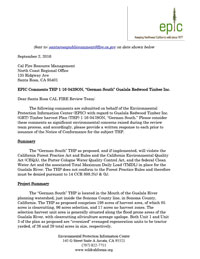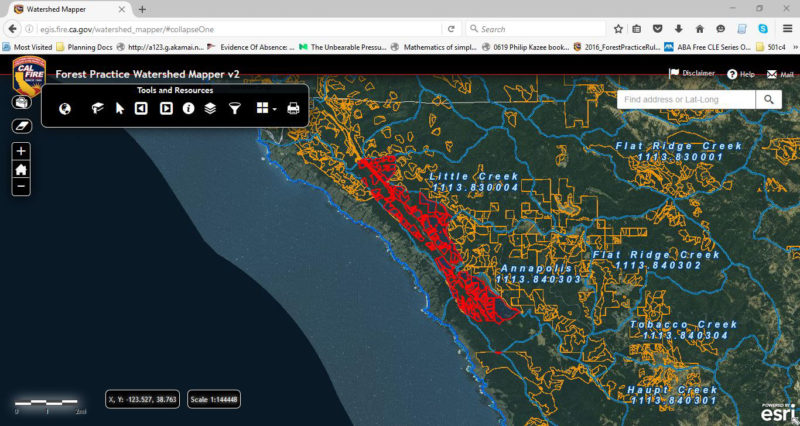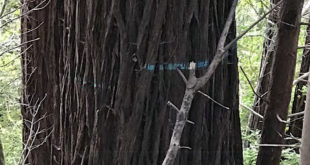Note: Close of public comment for this plan is Monday, September 12, 2016, at 5 p.m.

September 2, 2016
Cal Fire Resource Management
North Coast Regional Office
135 Ridgway Ave
Santa Rosa, CA 95401
EPIC Comments on THP 1-16-042SON,
“German South,” Gualala Redwood Timber Inc.
Dear Santa Rosa CAL FIRE Review Team:
The following comments are submitted on behalf of the Environmental Protection Information Center (EPIC) with regard to Gualala Redwood Timber Inc. (GRT) Timber harvest Plan (THP) 1-16-047SON, “German South.” Please consider these comments as significant environmental concerns raised during the review team process, and accordingly, please provide a written response to each prior to issuance of the Notice of Conformance for the subject-THP.
Summary
The “German South” THP as proposed, and if implemented, will violate the California Forest Practice Act and Rules and the California Environmental Quality Act (CEQA), the Porter-Cologne Water Quality Control Act, and the federal Clean Water Act and the associated Total Maximum Daily Load (TMDL) in place for the Gualala River. The THP does not conform to the Forest Practice Rules and therefore must be denied pursuant to 14 CCR 898.2(c) & (h).
Project Summary
The “German South” THP is located in the Mouth of the Gualala River planning watershed, just inside the Sonoma County line, in Sonoma County, California. The THP as proposed comprises 198 acres of harvest area, of which 85 acres is clearcutting, 96 acres selection, and 17 acres no-harvest zones. The selection harvest unit area is generally situated along the flood-prone areas of the Gualala River, with clearcutting silviculture acreage upslope. Both Unit 1 and Unit 3 of the plan as proposed are “oversized” evenaged regeneration units to be tractor yarded, of 26 and 29 total acres in size, respectively.
The Gualala River watershed and the Mouth of Gualala River planning watershed specifically have had and presently continue to have extant populations of federally-threatened Steelhead trout, and state and federally-endangered listed Central Coast Coho salmon. The Mouth of the Gualala River watershed is in the coastal anadromy zone for purposes of Forest Practice Rules implementation, and, as such the coastal anadromy zone rules contained in 14 CCR 916.9 (ASP Rules), apply to the “German South,” THP. The Gualala River watershed is also listed as water quality impaired due to excessive sedimentation under section 303(d) of the federal Clean Water Act, and a Total Maximum Daily Load (TMDL) has been established. (EPA 1998).
The Mouth of the Gualala River planning watershed has been subjected to extensive harvesting in recently-recorded history, with a cumulative total area of over 2,509 acres of harvest foot-print area since 1997 in the 5,302-acre planning watershed, according to records maintained by CAL FIRE. Below is a visual screen-shot representation of the recent (last 20 years) harvest history (represented in red) in the Mouth of Gualala River watershed:

According to Section III, page 96 of the proposed THP, stands to be harvested are approximately 90-100 years-old, with pre-harvest stocking ranging from 100 to up to 400 sq. ft. basal per-acre. Site productivity capacity is rated generally as Site Class III with some areas in the flood-plain characterized as Site Class I. (Ibid.).
Significant Environmental Concerns
1. Authorization of alternative watercourse and lake protection zone practices in lieu of standard ASP Rules
The Anadromous Salmonid Protection Rules (ASP Rules), were adopted by the Board of Forestry in 2009 to address long-recognized deficiencies in effectiveness of the California Forest Practice Rules to protect, enhance, maintain, and restore properly functioning habitat conditions for listed anadramous salmonids in North Coast and Central Coast watersheds during the course of conducting timber harvesting activities on private lands.
In its Final Statement of Reasons for adopting the ASP Rules, the Board states, “the adopted rules are intended to protect, maintain, and improve riparian habitats for listed anadromous salmonid species.” (FSOR, at p. 1 of 14). (Attachment A). The ASP Rules represent the permanent replacement to the previous-interim regulations adopted by the Board of Forestry to address impacts to listed anadramous salmonids and impaired waterbodies, known and the “Threatened and Impaired Watershed Rules,” (T&I Rules). The T&I Rules were adopted by the Board of Forestry as emergency rules on an interim basis, and subsequently re-adopted over a period of nearly 10 years until the final adoption of the ASP Rules.
In adopting the ASP Rules, the Board of Forestry was clear in its acknowledgment that the Rules will not fully address all issues as pertains to protection of all beneficial uses of water, stating, “[t]he Board acknowledges that this rule does not fully address Clean Water Act section 303(d) listed waterbodies, long term monitoring and adaptive management, road construction and maintenance, and cumulative impacts. This rule is primarily intended to address anadromous salmonid protection.” (FSOR, at p. 7 of 14).
Therefore, for the purposes of complying with the Rules more completely, and other applicable laws, as required per 14 CCR 896, individual THPs must include mitigations and other operational alternatives to ensure not only that listed anadramous salmonids are protected, but also to ensure that other beneficial uses of water are protected, and that applicable standards and targets of approved TMDLs are attained. (See: 14 CCR 916.9(a)(1)).
The “German South” THP proposes a slew of non-standard, alternative, and in-lieu practices and procedures that deviate from standard ASP Rule protection measures meant to ensure protection of listed salmonids and to contribute to the protection and attainment of Water Quality Standards, Water Quality Objectives, and TMDL Load Allocations and Load Reduction Targets established for the Gualala River. (Attachment B).
For example, Section II, Item #26(0) on page 34 of the plan indicates under the “Preferred Management Practices,” within Inner Zones A & B for Class I watercourses with Flood-Prone Areas that the standard prohibition on water drafting within these zones will not be observed because it is not feasible to do so (See #6). The Addendum to this item found at Section III, page 100 of the “German contained therein refers only to water drafting sites located on the South Fork Gualala River, which is not where the THP is located, and therefore, presumably is not where the activity of water drafting in the Class I Inner Zone A and B is being proposed and avoidance thereof is deemed to be infeasible by the plan submitter.
The allowance of water drafting in Inner Zones A and B of a Class I WLPZ in a watershed with listed salmonids is plainly contrary to one of the goal of the ASP Rules, which is to avoid significant adverse impacts to stream flows during the course of timber operations. (See: 14 CCR 916.9(a)(5)).
The “German South” THP does not adequately assess, or provide information to inform a meaningful assessment of potentially significant adverse impacts on stream flows in the South Fork Gualala River as a result of water drafting operations contemplated in the THP. In reviewing the plan, there appears to be no discussion of present or anticipated water availability in the THP area to be affected by water drafting operations within the Inner Zone A and B of the Class I WLPZ for the Mouth or the Gualala River watershed; the only reference to water quantity found in the THP is in Section IV, page 133 of the plan, wherein there is a table showing estimated water uses and withdrawl rates for the Gualala River watershed, as represented.
However, the source of this table and information is not provided; furthermore, the information seems to apply generically, and to the entirety of the Gualala River, and not specifically to the planning watershed in which the THP is actually located. Further, this table does not provide a category for water quantity assessment and diversion/withdrawl amounts associated with timber operations, which is the activity at issue in the THP itself. In sum, it appears the plan submitter has not provided any information of meaning, or that can be sourced, verified or corroborated, to demonstrate any attempt at assessing potentially significant impacts to stream flows and water quantity as pertains to the actual THP itself, or to allow CAL FIRE or the public to assess baseline conditions with respect to water quantity or whether activities proposed pertaining to water drafting and water withdrawl will have a significant adverse impact on stream flows, water quantity, or listed salmonids.
This is just one example of how the plan submitter has failed to provide evidence to support claims made with regard to avoidance or mitigation of significant adverse impacts to listed salmonids and other beneficial uses of water from proposed alternative, non-standard, and in-lieu practices in sensitive riparian Class I and II WLPZ and in flood-prone areas. Again, these activities are plainly contrary to the goals of the Forest Practice Rules and ASP Rules specifically, and allowance of such activities must not only be explained and justified, but also predicated upon a finding by CAL FIRE that significant adverse impacts will be avoided or mitigated to insignificance; such determination predicated upon professional judgement and discretion must be supported by substantial evidence in light of the whole of the record before CAL FIRE at the time of approval; it is simply not good enough to accept whole-sale the contents of the plan submitter to the extent these contentions and statements are not supported by actual evidence.
2. Failure to Ensure Compliance with Gualala River TMDL, Load Allocation, and Sediment Reduction Target Objectives
The “German South” THP does not provide adequate information or mitigation to ensure compliance with the TMDL for the Gualala River (EPA 1998), which requires assurance of compliance with the designated load allocation and the Sediment Reduction Targets established. The TMDL establishes a sediment load allocation for the Gualala at 125 percent, and establishes a 475 tons/sq. mile/per-year on a ten-year average. (EPA 1998, p. 16 of 21). The TMDL notes that given that at time of analysis the rate of anthropogenic sediment delivery from timber harvesting related activities was 840 tons/sq. mile/per-year, that “significant reductions,” in human induced sediment are needed to protect listed salmonids. (Ibid.).
Yet, the landslide information available in the THP at Section V, pages 241-245 of the “German South” THP is extremely antiquated and likely, entirely useless to allow CAL FIRE or the public to assess baseline conditions and thereby make a reasoned assessment and determination of how or if landslides resulting from timber operations will add to existing conditions, which are not known or disclosed, or if new or reactivated landslides that could result from timber operations will contribute to the ongoing sediment impairment in the Gualala River in quantities that will result in exceedance of Numeric Targets, or serve to hinder overall Sediment Reduction Targets and Objectives necessary to attain water quality standards. The landslide information provided does not present information for any period more recent than 2004, some 12 years ago. This lack of recent and relevant information and disclosure betrays a lack of substantial evidence and information to inform CAL FIRE or the public about the potential for significant adverse impacts resulting from THP operations, and therefore calls into question the evidentiary integrity and basis for findings by the RPF that no significant adverse impact will occur as a result of timber operations as proposed.
The THP appears to completely lack any acknowledgment of the TMDL Load Allocation or Numeric Sediment Reduction Targets and Objectives, generally, and simply does not contain enough information for anyone to verify or have any confidence in sweeping unsubstantiated qualitative statements made in the Plan by the RPF and plan submitter. Again, there is a notable lack of substantial evidence to support large portions of the analysis provided and statements made in the THP, particularly as pertains to baseline conditions, and anticipated future conditions resulting from harvesting as proposed, and how these may affect attainment of TMDL Load Allocations and Sediment Reduction Numeric Targets and Objectives.
The lack of recent data and other information to support conclusions made that would rise to the level of substantial evidence not only leaves the THP, if implemented, at risk of violating the TMDL and Clean Water Act, but also violate the goals of the Forest Practice Rules and the ASP Rules, which plainly provide that compliance with applicable TMDLs is an overarching goal and mandate. (See: 14 CCR 916.9(a)(1)).
3. Lack of Adequate and Meaningful Cumulative Impacts Analysis
The Forest Practice Act and Rules require a comprehensive evaluation of potentially significant adverse impacts on the environment in accordance with the requirements of CEQA, which include an analysis and consideration of cumulative impacts. (See: 14 CCR 898). As noted by the Board of Forestry’s FSOR for adoption of the ASP Rules:
“Under 14 CCR section 898, CALFIRE is also required to supplement the information provided by the RPF and the plan submitter when necessary to ensure all relevant information is considered. Timber harvest plans located in watersheds with listed salmonids and meeting the geographic scope of the Anadromous Salmonid Protection (ASP) rules will also have to comply with the CEQA and FPR requirements for cumulative impacts analysis and disclosure, and the requirement to substantially reduce or avoid adverse effects, including adverse cumulative effects of the proposed harvest and operations. The ASP rules do not substitute for this requirement.” (FSOR at p. 10 of 14).
Furthermore, the intent of the Board in adopting the ASP Rules was not to simply maintain status quo or avoid additional impacts:
“Secondly, the proposed rules are designed to make positive cumulative improvements to riparian areas and their beneficial functions for creating and maintaining salmonid habitat in watersheds hosting listed anadromous salmonids. The proposed Anadromous Salmonid Protection Rules approved by the Board are intended to address the legacy cumulative impacts and improve the future condition of riparian areas and salmonid habitat in these watersheds.” (Ibid).
This mandate is borne out at 14 CCR 916.9(c), which provides that any timber operations within an ASP WLPZ shall have the protection, maintenance, and restoration of properly functioning aquatic habitat conditions for listed salmonids among the primary objectives of any such operations. Thus, the goal, and indeed the mandate, is not to simply avoid or mitigate to insignificance, but rather to contribute to protection, enhancement, restoration and recovery of habitat for listed salmonids. Doing this requires a genuine consideration and rendering of pre-existing conditions in the watershed to be impacted by proposed timber operations; however, almost all the offsetting mitigation information provided in the THP in Sections IV and V as pertains to road work and remediation and LWD recruitment and placement are for the South Fork Gualala River planning watershed, and not the Mouth of the Gualala planning watershed, where the THP is actually located.
More generally, the “German South” THP is lacking in documentable, verifiable, information of any kind to support any of the conclusions reached in the cumulative impacts assessment provided in Section IV to comply with 14 CCR 912.9. For example, a basic and fundamental requirement and standard of professional practice is to “list and briefly describe,” all individuals and sources of information utilized in the cumulative impacts assessment. (See: Technical Rule Addendum No. 2, “Identification of Information Sources.”). No such list of sources or citations is provided for the watershed impacts assessment section or the biological resources assessment section, and the assessment of Greenhouse Gas impacts and climate change appears contain a list of references, but none are more recent than 2007, some nine years ago.
It is impossible to imagine how CAL FIRE, or the reviewing public can have any confidence in the sweeping assertions made by the RPF and plan submitter in the cumulative impacts assessment when no source citations, material, or in truth, evidence of any kind, is provided to support the statements and assertions. It appears from a thorough review of the cumulative impacts assessment provided in Section IV of the “German South” THP as propose that the RPF and plan submitter have “mailed it in,” and provided nothing of use or meaning in the way of a meaningful evaluation and assessment of the THP and how or if its impacts on the environment may combine with pre-existing cumulative impacts to result in further significant adverse cumulative impacts.
Conclusion
The “German South” THP is woefully inadequate to allow either CAL FIRE as lead agency or the public at-large to have any confidence in the conclusions and assertions being made by the RPF and plan submitter that no significant adverse impacts or cumulative impacts will result from the operation of the THP as proposed when past, present, and likely future activities are considered. The very fact that this THP was recommended for approval by the CAL FIRE review team chair raises substantial questions about the integrity of administration of the THP program as Certified Regulatory Program that is functionally equivalent to that of and Environmental Impact Report for purposes of CEQA. The conclusions made in the THP with respect to potentially significant adverse and cumulative impacts on the environment are not supported in any way by evidence present in the THP itself or elsewhere in light of the whole of the record as presented at this time, yet CAL FIRE seems all too willing to allow its review and approval process to facilitate the approval of an inadequate and likely ineffective environmental document that provides no assurance of compliance with the Forest Practice Act or Rules, CEQA, or other applicable governing laws and standards. Given what is articulated herein, and in other public concerns, the “German South” THP simply does not comply with the law and must be denied or substantially revised in order to pass muster of the “laugh test,” insofar as its completeness, adequacy, and integrity to assure the public that the rules and standards of the Board of Forestry truly constitute a comprehensive and effective system of regulation that complies with the Act, CEQA, and other laws.
Sincerely,
Rob DiPerna
California Forest and Wildlife Advocate
Environmental Protection Information Center
145 G Street, Suite A
Arcata, California 95521
Office: (707) 822-7711
Email: rob@wildcalifornia.org
Enclosures:
Attachment A: Board of Forestry and Fire Protection (2009), Final Statement of Reasons to Support Adoption of Anadramous Salmonid Protection Rules. October 7, 2009.
Attachment B: Environmental Protection Agency (1998), Total Maximum Daily Load for Gualala River.
 Friends of Gualala River Protecting the Gualala River watershed and the species living within it
Friends of Gualala River Protecting the Gualala River watershed and the species living within it


